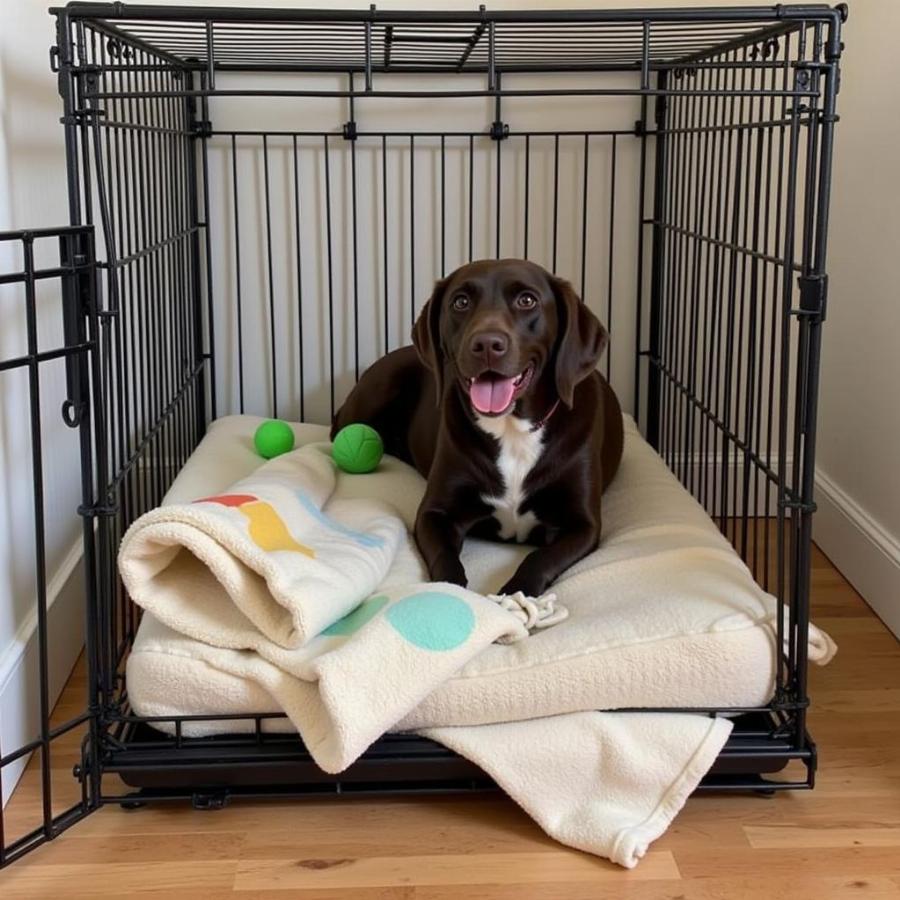A crate can be a wonderful tool for dogs, providing a safe haven, aiding in housebreaking, and offering a sense of security. However, for dogs with high anxiety, the crate can become a source of stress rather than comfort. This article delves into the reasons behind high anxiety in dog crates and provides practical solutions to help your furry friend feel safe and secure.
Why Some Dogs Experience High Anxiety in Crates
Before addressing the issue, it’s crucial to understand the root cause of your dog’s anxiety. Here are some common reasons:
- Past Trauma: Previous negative experiences, such as being confined for extended periods or associating the crate with punishment, can lead to crate anxiety.
- Separation Anxiety: Dogs with separation anxiety may panic when left alone, and the confinement of a crate can exacerbate this fear.
- Lack of Proper Introduction: Introducing a crate improperly or too abruptly can create negative associations for the dog.
- Confinement Duration: Leaving a dog in a crate for too long can be stressful and lead to anxiety, even for dogs without pre-existing issues.
- Medical Conditions: Underlying medical conditions causing pain or discomfort can contribute to a dog’s reluctance to be in a crate.
Signs of Crate Anxiety in Dogs
Recognizing the signs of crate anxiety is the first step towards helping your dog. Look out for these indicators:
- Whining, Barking, and Howling: Excessive vocalization, especially when left alone in the crate.
- Destructive Chewing: Attempts to escape the crate by chewing or scratching at the bars.
- Panting and Drooling: Physical signs of stress and anxiety, even in a cool environment.
- Pacing and Restlessness: Inability to settle down or find a comfortable position inside the crate.
- Elimination Accidents: Urinating or defecating in the crate, even if housetrained.
Creating a Positive Crate Experience
Turning your dog’s crate into a positive space requires patience, consistency, and a gentle approach:
- Choose the Right Crate: Ensure the crate is the right size for your dog to stand up, turn around, and lie down comfortably.
- Make it Inviting: Place a comfortable bed or blanket inside, along with safe and engaging toys.
- Positive Reinforcement: Use treats, praise, and their favorite toys to reward calm behavior inside the crate.
- Gradual Introduction: Start with short durations in the crate while you’re present, gradually increasing the time as your dog becomes more comfortable.
- Feed Meals in the Crate: Associate the crate with positive experiences by feeding meals inside.
- Never Use the Crate as Punishment: This will only create negative associations and worsen anxiety.
 Dog Crate Setup to Minimize Anxiety
Dog Crate Setup to Minimize Anxiety
Additional Tips for Dogs with High Anxiety
- Consult a Professional: Consider consulting a certified dog trainer or veterinary behaviorist for personalized guidance. They can assess your dog’s specific needs and develop a tailored training plan.
- Desensitization and Counterconditioning: These techniques involve gradually exposing your dog to the crate and associating it with positive experiences.
- Anxiety-Reducing Products: Consider using pheromone diffusers, calming treats or supplements, or anxiety vests to promote relaxation. However, consult with your veterinarian before introducing any new products.
- Create a Safe Space Outside the Crate: Offer a designated safe space outside the crate with a comfortable bed and toys where your dog feels secure.
- Manage Separation Anxiety: If separation anxiety is a factor, address this issue separately through training and desensitization techniques.
Patience and Consistency are Key
Remember, helping a dog with high crate anxiety takes time and patience. Be consistent with your training, remain patient and positive, and celebrate small victories along the way. By understanding the reasons behind your dog’s anxiety and implementing the right strategies, you can help them overcome their fear and view the crate as a safe and comfortable space.
FAQs About High Anxiety Dog Crates
Q: How long does it take to help a dog with crate anxiety?
A: The time it takes varies depending on the severity of the anxiety and the dog’s individual response to training. Some dogs may show improvement within a few weeks, while others might take several months.
Q: Can I leave my dog in the crate while I’m at work?
A: It depends on your dog’s age, bladder control, and anxiety level. Puppies generally can’t hold their bladder for extended periods and shouldn’t be crated for longer than a couple of hours.
Q: What if my dog continues to have severe anxiety despite my efforts?
A: If you’ve tried various strategies without success, consult with a certified dog trainer or veterinary behaviorist. They can provide personalized guidance and advanced training techniques.
Need more help with your dog’s crate anxiety? Check out our article on dog car anxiety for tips on managing anxiety in different situations. You can also explore our selection of 30 inch crate for dog to find the perfect size for your furry friend.
Beaut Dogs is your trusted resource for all things dog-related. We provide expert advice and information on a wide range of topics, from breed characteristics to training tips and health concerns. For personalized support, contact us at [email protected]. Let Beaut Dogs help you navigate the wonderful world of dog ownership with confidence and care.